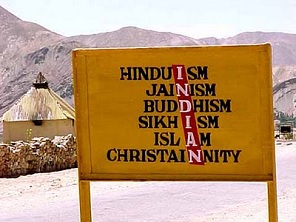Wolff, Diane, Tibet Unconquered: An Epic Struggle for Freedom, Palgrave McMillan, New York, 2009, 248pp. Foreword by Robert Thurman.
The publisher kindly provided a copy of this book for review.
A year ago, my Holiday 2009 Book Roundup on chicagoboyz here recommended Christopher Beckwith’s Empires of the Silk Road as an outstanding overview of Central Asian culture from prehistory to the present day. Complementing that title is Diane Wolff’s new and approachable overview of Tibet’s relationship with China.
It’s hard to imagine an extended American family that doesn’t have at least one member who’s been fascinated by Tibetan Buddhism in some way. The Dalai Lama remains as one of the few religious leaders given wide respect in the Western world. His recent emphasis on the preservation of Tibet’s environment (which forms the headwaters of five major Asian river systems) gives him even more popularity with Greens. As Wolff notes, Buddhism has been the default “cool” religion in Hollywood for many years apart from the recent and occasional forays into Jewish Kabbalah by the Malibu crowd. In turn, Tibetan Buddhism also appeals to adolescents looking for a way to peeve their parents … without getting kicked out of the house.
A book that tries to give a general reader a solid historical understanding of Chinese-Tibetan relations is welcome. It’s a tangled and tragic piece of history, one fraught with opportunities missed on both sides and historical trends that have largely worked against Tibetan culture. We have a vivid “virtual Tibet” (in Orville Schell’s phrasing) but will we still have a Tibetan culture in 2050? Wolff offers a heart-felt and practical solution to the current style of Han occupation of Tibet. She’s also realistic enough to understand that the current generation of Chinese leaders may not be suited to making the adjustments and compromises necessary to pull a Tibetan thorn from the Chinese paw. A Fifth Generation of Chinese Communist Party leaders may be needed.
Wolff’s book is written for the non-specialist. It requires close reading (because she often approaches subjects thematically with a certain amount of bouncing back and forth between time periods) but Tibet Unconquered is pitched for mortal readers, without a forest of footnotes.
An intelligent high school student can easily make their way through this book, with profit. So if you’ve suddenly found your kids flying Tibetan prayer flags in your backyard, Diane Wolff’s book definitely belongs on your 2010 holiday book buying list. You can bask in some of that reflected “cool” yourself. It’s a very affordable, useful introduction to a fascinating subject. It works fine as a springboard to the specialist literature for motivated readers. Those interested in China’s capacity to adapt to a world demanding more transparency, more honesty and more credible self-reflection could hardly find a better ongoing touchstone than Tibet. Educating yourself about how things got the way they did in Tibet (and China) is therefore well worth the time. The Han Chinese have plenty of challenges facing them. Tibet is where the world proclaims they are most “uncivilized.” That’s a slur the Han cannot, cannot bear after a millennium ruled largely by northern barbarians and more recent humiliations by industrial nations. So the Roof of the World is where the Han must come to a successful solution without losing face. For them, let alone the poor Tibetans, the stakes couldn’t be higher. It’s a situation worth watching.
Even better for those of you racing into the e-book world, Amazon offers an even more affordable Tibet Unconquered. Consider this title as a gift or for a thought-provoking bit of holiday reading.


